Looking to buy a piece of Utah land? You’re not alone. From first‑time investors to families hunting for a weekend getaway spot, the state’s varied terrain makes it appealing. But before you sign any contract, you should know the real numbers and the factors that push those numbers up or down.
Location is the biggest driver. A half‑acre in downtown Salt Lake City can cost several hundred thousand dollars, while the same size in a remote part of Box Elder County might be under $10,000. Proximity to major highways, schools, and future development plans also matter. Areas with planned infrastructure—like new transit lines or water projects—usually see price jumps.
Land use zoning plays a big role, too. Residential zones command higher prices than agricultural or industrial zones because they’re easier to build homes on. Check the county’s zoning map before you fall in love with a parcel; a zoning change can add or shave thousands off the price.
Supply and demand dynamics shift seasonally. Summer sees a spike in buyer activity, which can push prices up by 5‑10% in popular counties. Conversely, winter months may bring lower demand and better deals, especially in mountain regions where snow makes access tougher.
Lastly, the overall real‑estate market in Utah influences land costs. When home prices soar, investors look for cheaper entry points, driving up land demand. When mortgage rates climb, both buyers and investors pull back, softening land prices.
Do your homework on recent sales. County assessor websites list last‑year sale prices for most parcels. Compare at least three recent sales in the same area to gauge a fair price.
Don’t ignore hidden costs. Closing fees, title searches, and especially utility hookups can add $5,000‑$20,000 to your budget. Ask the seller for a breakdown of any existing liens or unpaid taxes before you make an offer.
Consider land with existing infrastructure. If the lot already has water, electricity, or road access, you’ll save a lot of money compared to a raw parcel that needs all that work done from scratch.
Negotiate the price based on improvements needed. If a lot needs grading, soil testing, or environmental clearances, use those numbers to lower your offer. Sellers often overlook these expenses and will be willing to cut a few thousand dollars.
Work with a local real‑estate agent who knows the county. They can spot red flags—like flood zones or future highway expansions—before you get stuck with a bad investment.
Finally, be patient. The Utah land market moves fast in hot spots, but there are still bargains in less‑talked‑about counties. If a deal feels rushed, step back, re‑evaluate, and wait for a better opportunity.
Understanding the basics of Utah land costs helps you avoid overpaying and makes the buying process smoother. Keep an eye on location, zoning, market trends, and hidden fees, and you’ll be in a strong position to find land that fits both your budget and your dreams.

Are you contemplating a move to either Utah or Texas and curious about land prices? This article explores whether it’s cheaper to live in Utah or Texas focusing on land costs and other living expenses. It delves into property taxes, community life, and general affordability. An ideal read for those looking to make informed real estate decisions.